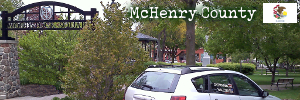















Crash Reports - who is Unit 1? |
|---|

|
Gus Philpott
Woodstock Advocate
May 8, 2010
The Illinois Traffic Crash Report (Form SR10505) has blocks for information that are labeled Unit 1 and Unit 2. Driver information and vehicle information are reported in those blocks, including names, addresses, DOBs, phone numbers, vehicle description, license plate, VIN, etc. A small vehicle depiction is shown where the reporting officer circles the areas of damage on the vehicles.
One recent crash report was of particular interest to me, because the deputy who caused the crash was listed as Unit 2 in the report prepared by an Illinois State Police trooper who investigated the crash. Unit 2 is the vehicle and the driver not at fault or at lesser fault than the driver of Unit 1.
Unit 1 is the spot for the driver who was at fault (or more at fault) in the crash.
Now, let's say a civilian is the driver of Unit 1 and a deputy is the driver of Unit 2. The civilian driver, identified as Unit 1 and the at-fault driver, would most likely get a ticket; right? And the deputy, driver of Unit 2, would be less-at-fault or not at fault and would not get a ticket.
Certainly McHenry County would not pay for the damage to Unit 1, if the driver were at fault; right?
But consider this. For this crash on November 16, 2009, the driver of Unit 1 not only did not get a ticket, but the County paid for the damage to her car.
At least, in this crash.
In this crash both vehicles were westbound on Ringwood Road last November. Unit 2 (the squad car) was in front of Unit 1. The deputy spotted two mini-bikes heading east. The deputy pulled off toward the right shoulder and began a left U-turn. As he started to make his U-turn, Unit 2 was passing him, and the left front of the squad car hit the right front wheel well and passenger door of Unit 2. The overhead emergency lights of the squad car had not been turned on.
In his eagerness to nail the operators of the two mini-bikes, it looks to me like he just neglected to check for following traffic and started his U-turn. Then bam! A witness, traveling east, saw the crash and stopped, providing her name to the deputy and to the State trooper.
The trooper's report reads, "Unit 1 appears to have contacted the front driver side corner of Unit 2 with the front passenger wheel well and door of Unit 1."
The trooper's report is carefully worded to steer fault away from the deputy. What's clear is that the squad car was moving forward in a U-turn as the civilian drove by. That is how the damage occurred to the right side of the civilian's car!
Unlike in another and similar crash back in July 2008, the damage to the civilian's car was paid for by the County. Now, how could that happen? In the previous crash the civilian was entered as Unit 1 on that previous crash report, didn't get a ticket and, in spite of persistent claims, was refused payment by the County for the damage to her car, because she was listed as Unit 1 (the at-fault vehicle).
When deputies are at fault in crashes, shouldn't they be listed as Unit 1 and get tickets, just as civilians do when they cause crashes? Deputies drive a lot of miles and are generally good, careful drivers. Sometimes they make mistakes; we all do.
If a deputy's supervisor or state trooper "gives a break" to a deputy, how can he in good faith issue a ticket to the next civilian driver who causes a crash?
